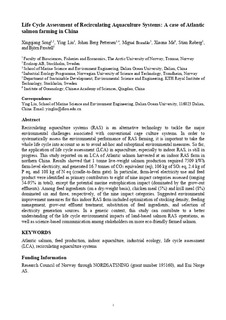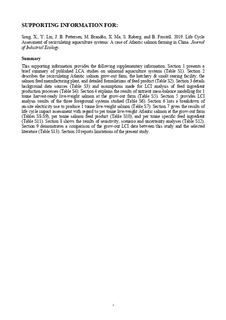| dc.contributor.author | Song, Xingqiang | |
| dc.contributor.author | Liu, Ying | |
| dc.contributor.author | Pettersen, Johan Berg | |
| dc.contributor.author | Brandão, Miguel | |
| dc.contributor.author | Ma, Xiaona | |
| dc.contributor.author | Røberg, Stian | |
| dc.contributor.author | Frostell, Björn | |
| dc.date.accessioned | 2019-12-05T12:21:22Z | |
| dc.date.available | 2019-12-05T12:21:22Z | |
| dc.date.created | 2019-06-20T10:31:43Z | |
| dc.date.issued | 2019 | |
| dc.identifier.citation | Journal of Industrial Ecology. 2019, 23 (5), 1077-1086. | nb_NO |
| dc.identifier.issn | 1088-1980 | |
| dc.identifier.uri | http://hdl.handle.net/11250/2631969 | |
| dc.description.abstract | Recirculating aquaculture systems (RAS) are an alternative technology to tackle the major environmental challenges associated with conventional cage culture systems. In order to systematically assess the environmental performance of RAS farming, it is important to take the whole life cycleintoaccountsoastoavoidadhocandsuboptimalenvironmentalmeasures.Sofar,theapplication of life cycle assessment (LCA) in aquaculture, especially to indoor RAS, is still in progress. This study reports on an LCA of Atlantic salmon harvested at an indoor RAS farm in northern China. Results showed that 1 tonne live-weight salmon production required 7,509 kWh farmlevel electricity and generated 16.7 tonnes of CO2 equivalent (eq), 106 kg of SO2 eq, 2.4 kg of P eq, and 108 kg of N eq (cradle-to-farm gate). In particular, farm-level electricity use and feed product were identified as primary contributors to eight of nine impact categories assessed (54–95% in total), except the potential marine eutrophication (MEU) impact (dominated by the grow-out effluents). Among feed ingredients (on a dry-weight basis), chicken meal (5%) and krill meal(8%)dominatedsixandthree,respectively,ofthenineimpactcategories.SuggestedenvironmentalimprovementmeasuresforthisindoorRASfarmincludedoptimizationofstockingdensity, feedingmanagement,grow-outeffluenttreatment,substitutionoffeedingredients,andselection ofelectricitygenerationsources.Inagenericcontext,thisstudycancontributetoabetterunderstanding of the life cycle environmental impacts of land-based salmon RAS operations, as well as science-basedcommunicationamongstakeholdersonmoreeco-friendlyfarmedsalmon | nb_NO |
| dc.description.abstract | Life cycle assessment of recirculating aquaculture systems: A case of Atlantic salmon farming in China | nb_NO |
| dc.language.iso | eng | nb_NO |
| dc.publisher | Wiley | nb_NO |
| dc.subject | Industriell økologi | nb_NO |
| dc.subject | Industrial Ecology | nb_NO |
| dc.title | Life cycle assessment of recirculating aquaculture systems: A case of Atlantic salmon farming in China | nb_NO |
| dc.type | Journal article | nb_NO |
| dc.type | Peer reviewed | nb_NO |
| dc.description.version | acceptedVersion | nb_NO |
| dc.subject.nsi | VDP::Matematikk og naturvitenskap: 400 | nb_NO |
| dc.subject.nsi | VDP::Mathematics and natural scienses: 400 | nb_NO |
| dc.source.pagenumber | 1077-1086 | nb_NO |
| dc.source.volume | 23 | nb_NO |
| dc.source.journal | Journal of Industrial Ecology | nb_NO |
| dc.source.issue | 5 | nb_NO |
| dc.identifier.doi | 10.1111/jiec.12845 | |
| dc.identifier.cristin | 1706341 | |
| dc.relation.project | Næringsliv: Eni Norge AS | nb_NO |
| dc.relation.project | Norges forskningsråd: RCN 195160 | nb_NO |
| dc.description.localcode | Locked until 1.4.2020 due to copyright restrictions. This is the peer reviewed version of an article, which has been published in final form at [https://doi.org/10.1111/jiec.12845]. This article may be used for non-commercial purposes in accordance with Wiley Terms and Conditions for Self-Archiving. | nb_NO |
| cristin.unitcode | 194,64,25,0 | |
| cristin.unitname | Institutt for energi- og prosessteknikk | |
| cristin.ispublished | true | |
| cristin.fulltext | original | |
| cristin.qualitycode | 2 | |

